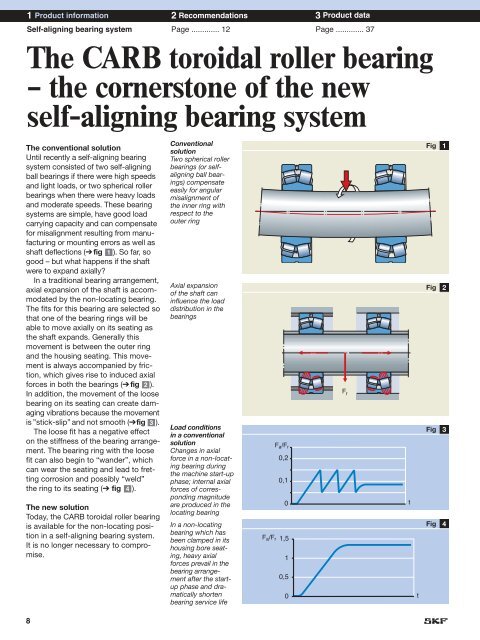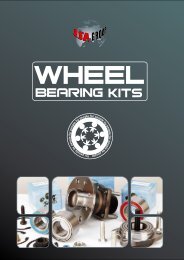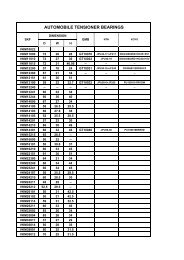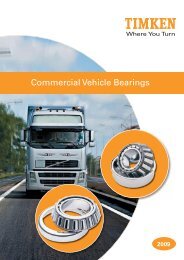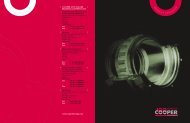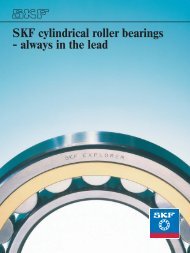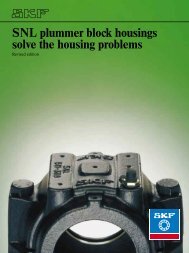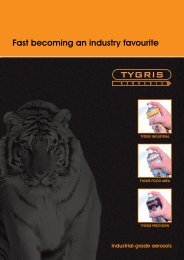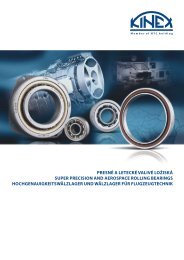CARB® toroidal roller bearings â a revolutionary ... - Acorn Bearings
CARB® toroidal roller bearings â a revolutionary ... - Acorn Bearings
CARB® toroidal roller bearings â a revolutionary ... - Acorn Bearings
Create successful ePaper yourself
Turn your PDF publications into a flip-book with our unique Google optimized e-Paper software.
1 Product information 2 Recommendations 3 Product data<br />
Self-aligning bearing system Page ............. 12 Page ............. 37<br />
The CARB <strong>toroidal</strong> <strong>roller</strong> bearing<br />
– the cornerstone of the new<br />
self-aligning bearing system<br />
The conventional solution<br />
Until recently a self-aligning bearing<br />
system consisted of two self-aligning<br />
ball <strong>bearings</strong> if there were high speeds<br />
and light loads, or two spherical <strong>roller</strong><br />
<strong>bearings</strong> when there were heavy loads<br />
and moderate speeds. These bearing<br />
systems are simple, have good load<br />
carrying capacity and can compensate<br />
for misalignment resulting from manufacturing<br />
or mounting errors as well as<br />
shaft deflections (➔ fig 1 ). So far, so<br />
good – but what happens if the shaft<br />
were to expand axially?<br />
In a traditional bearing arrangement,<br />
axial expansion of the shaft is accommodated<br />
by the non-locating bearing.<br />
The fits for this bearing are selected so<br />
that one of the bearing rings will be<br />
able to move axially on its seating as<br />
the shaft expands. Generally this<br />
movement is between the outer ring<br />
and the housing seating. This movement<br />
is always accompanied by friction,<br />
which gives rise to induced axial<br />
forces in both the <strong>bearings</strong> (➔ fig 2 ).<br />
In addition, the movement of the loose<br />
bearing on its seating can create damaging<br />
vibrations because the movement<br />
is ”stick-slip” and not smooth (➔fig 3 ).<br />
The loose fit has a negative effect<br />
on the stiffness of the bearing arrangement.<br />
The bearing ring with the loose<br />
fit can also begin to “wander”, which<br />
can wear the seating and lead to fretting<br />
corrosion and possibly “weld”<br />
the ring to its seating (➔ fig 4 ).<br />
The new solution<br />
Today, the CARB <strong>toroidal</strong> <strong>roller</strong> bearing<br />
is available for the non-locating position<br />
in a self-aligning bearing system.<br />
It is no longer necessary to compromise.<br />
8<br />
Conventional<br />
solution<br />
Two spherical <strong>roller</strong><br />
<strong>bearings</strong> (or selfaligning<br />
ball <strong>bearings</strong>)<br />
compensate<br />
easily for angular<br />
misalignment of<br />
the inner ring with<br />
respect to the<br />
outer ring<br />
Axial expansion<br />
of the shaft can<br />
influence the load<br />
distribution in the<br />
<strong>bearings</strong><br />
Load conditions<br />
in a conventional<br />
solution<br />
Changes in axial<br />
force in a non-locating<br />
bearing during<br />
the machine start-up<br />
phase; internal axial<br />
forces of corresponding<br />
magnitude<br />
are produced in the<br />
locating bearing<br />
In a non-locating<br />
bearing which has<br />
been clamped in its<br />
housing bore seating,<br />
heavy axial<br />
forces prevail in the<br />
bearing arrangement<br />
after the startup<br />
phase and dramatically<br />
shorten<br />
bearing service life<br />
F a /F r<br />
0,2<br />
0,1<br />
0<br />
F a /F r<br />
1,5<br />
1<br />
0,5<br />
0<br />
Fig<br />
Fig 2<br />
F r<br />
t<br />
t<br />
Fig<br />
Fig<br />
1<br />
3<br />
4


